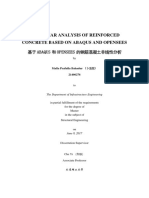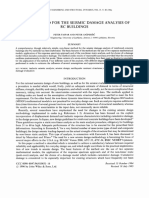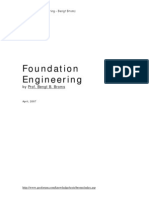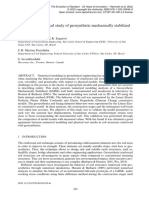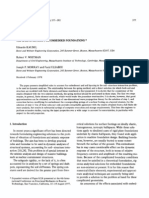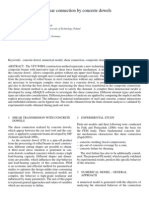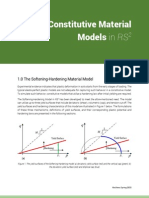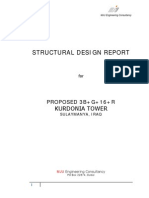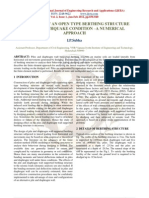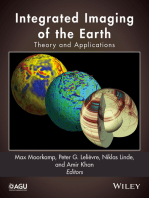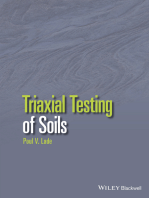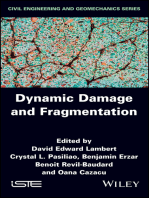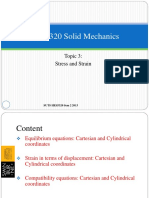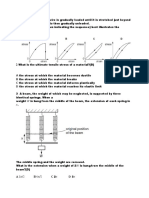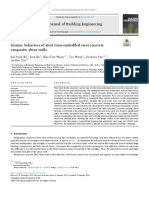GeoMos 2010 Schweiger
GeoMos 2010 Schweiger
Uploaded by
Iancu-Bogdan TeodoruCopyright:
Available Formats
GeoMos 2010 Schweiger
GeoMos 2010 Schweiger
Uploaded by
Iancu-Bogdan TeodoruOriginal Description:
Copyright
Available Formats
Share this document
Did you find this document useful?
Is this content inappropriate?
Copyright:
Available Formats
GeoMos 2010 Schweiger
GeoMos 2010 Schweiger
Uploaded by
Iancu-Bogdan TeodoruCopyright:
Available Formats
Reference:
H.F. Schweiger
Numerical analysis of deep excavations and tunnels in accordance with EC7 design
approaches
Proc. Int. Conference Geotechnical Challenges in Megacities (Petrukhin, Ulitsky, Kolybin, Lisyuk,
Kholmyansky, eds.), Moskau, 7.-10.6.2010, Vol. 1, 206-217
Numerical analysis of deep excavations and tunnels in accordance
with EC7 design approaches
H.F. Schweiger
Computational Geotechnics Group, Institute for Soil Mechanics and Foundation Engineering
Graz University of Technology, Austria
ABSTRACT: Numerical methods are well established in practical geotechnical engineering to assess the
deformation behaviour of deep excavations and tunnels. However, it becomes more and more common to use
results from numerical analysis for ultimate limit state design (ULS) and in these cases compatibility with
standards and codes of practice, valid in the respective country, has to be fulfilled. This is by no means straight-
forward and in this paper design approaches defined in EC7 will be applied to deep excavation and tunnelling
problems highlighting some key aspects. Secondly the importance of the appropriate choice of a constitutive
model for the soil is pointed out by comparing results obtained from different soil models.
1. INTRODUCTION
Numerical analyses are widely used in practical
geotechnical engineering to assess the deforma-
tion behaviour of deep excavations and tunnels,
in particular when the influence on existing
buildings has to be assessed or the interaction
between different structures has to be taken into
account. In addition a tendency can be ob-
served, namely to use results from numerical
analysis as basis for the design which is of
course only possible if compatibility with
relevant standards and codes of practice, valid
in the respective country, is guaranteed. In
general this is a well established procedure
when employing conventional design calcula-
tions based e.g. on limit equilibrium methods,
but there are no clear guidelines how this can be
achieved in the context of numerical modelling.
Therefore literature on this subject is not ex-
hausting, but some discussion on the compati-
bility of EC7 design approaches with numerical
analyses can be found in e.g. Bauduin et al.
(2000), Schweiger (2005, 2009), Simpson
(2000, 2007), Walter (2006).
An important aspect in any numerical analy-
sis in geotechnics, no matter whether ULS
(ultimate limit state) or SLS (serviceability limit
state) is considered, is the appropriate choice of
the constitutive model for the soil, which has a
direct consequence for the design because
different constitutive models will lead to differ-
ent structural forces. Both of these aspects are
addressed in this paper by means of benchmark
examples, i.e. the influence of the choice of the
constitiutive model on calculated displacements
and structural forces is investigated first and
then consequences for the design, employing
different design approaches, are discussed.
Finally, results form the analysis of two real
case histories, a station tunnel in soil and a deep
excavation in sand, is presented in order to
address specific problems relevant in practice.
It follows from these examples that the
choice of the constitutive model and the design
approach has an influence on the results, but
given the uncertainties inherent in any analysis
in geotechnical engineering the differences due
to the different EC7 design approaches seem
acceptable provided a suitable constitutive
model is employed.
2. EC7 DESIGN APPROACHES
In Eurocode7 the partial factor of safety concept
replaces the global factor of safety concept
employed until now. Three different design
approaches DA1 to DA3 have been specified
which differ in the application of the partial
factors of safety on actions, soil properties and
resistances. They are summarized in Tables 1
and 2 for all three approaches. It is noted that
two separate analyses are required for design
approach 1. The problem when using numerical
methods is immediately obvious because DA1/1
and DA2 require permanent unfavourable
actions to be factored by a partial factor of
safety, e.g. the earth pressures acting on struc-
tural elements such as retaining walls and tunnel
linings. This is of course not possible because in
numerical analyses the earth pressure is a result
of the analysis and not an input. However, EC7
allows for an alternative, namely of applying
the partial factor on the effect of the action
instead on the actions itself, e.g. bending mo-
ments or strut forces. This is commonly referred
to as DA2* and throughout this paper DA2 is
understood in the form of DA2*. Now numeri-
cal methods can be readily applied because the
analysis is performed with characteristic loads
and characteristic parameters introducing the
relevant partial factors at the end of the analysis.
It is beyond the scope of this contribution to
elaborate on the advantages and disadvantages
of each of the approaches in detail but some
discussion can be found e.g. in Simpson (2000,
2007), Bauduin et al. (2003) and Schweiger
(2005). However the differences in results
depending on the design approach employed
will be shown whereas special emphasis will be
put on the choice of the constitutive model.
Table 1. EC7 partial factors for actions
Design
Approach
Permanent
unfavourable
Variable
DA1/1 1.35 1.50
DA1/2 1.00 1.30
DA2 1.35 1.50
DA3 1.00 1.30
Table 2. EC7 partial factors for soil strength proper-
ties and resistances
Design
Approach
tan' c'
Undrained
shear strength
Passive
resistance
DA1/1 1.00 1.00 1.00 1.00
DA1/2 1.25 1.25 1.40 1.00
DA2 1.00 1.00 1.00 1.40
DA3 1.25 1.25 1.40 1.00
3. DEEP EXCAVATION BENCHMARKS
First, two deep excavation benchmarks are
discussed. Their general layout and the con-
struction sequence are similar but ground
conditions are different. A soft clay layer is
assumed in the first example whereas an over-
consolidated clay is considered in the second
example. Different constitutive models are
employed for modelling the mechanical behav-
iour of the soil, the simple Mohr-Coulomb
failure criterion (MC), the so called Hardening
Soil model (HS), the Hardening Soil Small
model (HSS) and the Soft Soil model (SS). All
models are standard models of the finite ele-
ment code Plaxis (Brinkgreve et al. 2006),
which has been used for all analyses presented
in this paper. The Hardening Soil model is an
elastic-plastic model featuring deviatoric and
volumetric yield surfaces (doubel hardening
model), the HSS model is the extension to
account for small strain stiffness effects (Benz
2007) and the Soft Soil model is a modification
of the well known Modified-Cam-Clay model
incorporating a Mohr-Coulomb failure criterion
and allowing for a modification of the volumet-
ric yield surface in order to improve K
0
-
predictions. Parameters are based on experi-
mental data and experience and can be consid-
ered representative for the type of soils investi-
gated in this study.
For simplicity the sheet pile wall (EA =
2.53E06 kN/m, EI =3.02E4 kNm
2
/m) and the
strut (EA =1.5E06 kN/m) have been assumed
the same for both ground conditions, only the
length of the wall and drainage conditions vary.
Wall friction was taken as 2/3 of the friction
angle of the soil.
First the influence of the constitutive model
on lateral displacement of the wall and bending
moments is presented. Secondly the influence of
the design approach on design forces is shown.
3.1. Problem definition soft clay layer
The geometry of the problem follows from
Figure 1 and the construction steps modelled in
the undrained analysis are as follows:
Step 0: Initial stress state
('
v
=.h, '
h
=K
0
'
v
, K
0
=1 - sin')
Step 1: Apply surcharge load
(permanent load of 10 kPa)
Step 2: Activate wall (wished-in-place)
set displacements to zero
Step 3: Excavation to level -2.0 m
Step 4: Activate strut at level -1.5 m
Step 5: Excavation to level -4.0 m
Step 6: Excavation to level -6.0 m
Step 7: Apply variable load of 15 kPa
(for comparison of design approaches)
Figure 1. Geometry of excavation in soft clay layer.
Table 3. Parameters for the HSS and SS model for
soft clay layer
Parameters HSS SS
, kN/m
3
15 15
sat
, kN/m
3
16 16
', 27 27
c', kPa 15 15
, 0 0
ur
0.2 0.2
E
50
ref
, kPa 4 300 -
E
oed
ref
, kPa 1 800 -
E
ur
ref
, kPa 14 400 -
m 0.9 -
p
ref
, kPa 100 -
K
0
nc
0.546 0.546
tens
, kPa 0 0
G
0
, kPa 25 000 -
0.7
0.0003 -
* - 0.0556
* - 0.0125
The parameters for the HSS model and the SS
model are listed in Table 3. The parameters for
the HS model are the same as given in Table 3,
with the exception of G
0
and
0.7
which do not
apply for this model. Stiffness parameters in the
advanced models are stress dependent (values in
Table 1 are reference values) but in the MC-
model a constant elasticity modulus has to be
used. The average value of loading and unload-
ing stiffness which follows from the HS model
at the base of the retaining wall has been as-
signed as stiffness in the latter, which results in
E
MC
= 4 650 kPa. Unit weight and strength
parameters are the same in all models. The
groundwater table is at a level of -2.0 m below
surface.
3.2. Results soft clay layer
Figures 2 and 3 depict lateral wall displace-
ments and bending moments for the wall
respectively. The difference between HS and
HSS models depends to a large extent on
0.7
(see Table 3) and a represenatative value based
on literature date has been chosen for this study.
The SS model gives the smallest displacements
and the MC model shows a different shape of
wall deflection, namely an almost parallel
movement of the bottom half of the wall, which
is in contrast to the other models. This behav-
iour also leads to differences in the bending
moments, which will be discussed again when
looking at design approaches.
horizontal wall displacement [mm]
-10 0 10 20 30 40 50 60
d
e
p
t
h
b
e
l
o
w
s
u
r
f
a
c
e
[
m
]
0
1
2
3
4
5
6
7
8
9
10
11
HS
HSS
MC
SS
Figure 2. Wall deflection - soft clay layer.
bending moments [kNm/m]
-150 -120 -90 -60 -30 0 30
d
e
p
t
h
b
e
l
o
w
s
u
r
f
a
c
e
[
m
]
0
1
2
3
4
5
6
7
8
9
10
11
HS
HSS
MC
SS
Figure 3. Bending moments - soft clay layer.
The settlement trough behind the wall (Figure
4) emphasizes the well known fact that elastic-
perfectly plastic constitutive models are not
capable of predicting the expected deformation
behaviour. A significant heave is observed
adjacent to the wall and in this case due to
undrained conditions settlements in the far
field (the lateral model boundary for this analy-
sis was placed at a distance of 75 m from the
wall). All other models calculate settlements,
with larger values for HS models than for the
SS model. The calculated settlement troughs
can be generally considered as too wide with
the exception of the HSS model which is a
consequence of taking into account small strain
stiffness effects.
distance from wall [m]
0 10 20 30 40 50 60 70
s
u
r
f
a
c
e
d
i
s
p
l
a
c
e
m
e
n
t
[
m
m
]
-30
-20
-10
0
10
20
30
40
50
60
HS
HSS
MC
SS
Figure 4. Surface settlements - soft clay layer.
3.3. Problem definition stiff clay layer
In this section the perfomance of the same
constitutive models as used above will be
evaluated for an excavation in an overconsoli-
dated clay. The calculation steps are the same as
described in section 3.1 but after installation of
the strut a ground water lowering inside the
excavation is performed to a level of -6.0 m.
The geometric layout is as shown in Figure 1,
but the wall is only 9 m deep in this case. The
pore water distribution at the front of the wall is
obtained from interpolation between excavation
level and base of the wall. Drained conditions
are assumed and the general ground water level
is 3.5 m below the surface.
The parameters for the constitutive models
are given in Table 4 and again the assumption is
made for the MC model that the elasticity
modulus is the average between E
50
and E
ur
of
the HS model at the base of the wall (-9.0 m),
thus E
MC
=82 000 kPa.
A overburden pressure of 1 000 kPa is applied
to model overconsolidation and K
0
=1.25.
Table 4. Parameters for the HSS and SS model for
stiff clay layer
Parameters HSS SS
, kN/m
3
17 17
sat
, kN/m
3
20 20
', 33 33
c', kPa 48 48
, 5 5
ur
0.2 0.2
E
50
ref
, kPa 30 000 -
E
oed
ref
, kPa 30 000 -
E
ur
ref
, kPa 100 000 -
m 0.65 -
p
ref
, kPa 100 -
K
0
nc
0.455 0.455
tens
, kPa 15 15
G
0
, kPa 150 000 -
0.7
0.0002 -
* - 0.00333
* - 0.0018
3.4. Results stiff clay layer
horizontal wall displacement [mm]
-2 -1 0 1 2 3 4 5 6 7
d
e
p
t
h
b
e
l
o
w
s
u
r
f
a
c
e
[
m
]
0
1
2
3
4
5
6
7
8
9
HSS
MC
HS
SS
Figure 5. Wall deflection - stiff clay layer.
bending moments [kNm/m]
-60 -50 -40 -30 -20 -10 0 10 20 30 40 50
d
e
p
t
h
b
e
l
o
w
s
u
r
f
a
c
e
[
m
]
0
1
2
3
4
5
6
7
8
9
HSS
MC
HS
SS
Figure 6. Bending moments - stiff clay layer.
In Figures 5 and 6 wall deflection and bending
moments are shown. As expected for a stiff soil
the deformations are small, but still differences
depending on the model can be observed.
Bending moments also vary, with the HSS
model resulting in the lowest bending moments
in this case and the HS model the largest. Given
the small lateral wall displacements, surface
settlements behind the wall will be negligible
and this indeed obtained (Figure 7). However
the MC-model again predicts significant heave
and only the HSS model shows the expected
result. HS and SS model show some heave in
the vicinity of the wall.
Abstand von Baugrubenwand [m]
0 10 20 30 40 50 60 70
O
b
e
r
f
l
c
h
e
n
s
e
t
z
u
n
g
[
m
m
]
-2
-1
0
1
2
3
4
5
6
7
8
HSS
MC
HS
SS
Figure 7. Surface settlements - stiff clay layer.
3.5. Influence of design approach
It is apparent from the previous sections that the
constitutive model used for describing the
mechanical behaviour of the soil has an influ-
ence on bending moments calculated and thus
on the design of the wall. In the following these
differences are investigated in terms of the
different design approaches introdcued in
section 2. The calculation steps are the same as
in the previous sections but an additional
variable load of 15 kPa extending to a width of
5 m is added as a final calculation step in order
to have the influence of a variable load taken
into account (see Figure 1). Again the soft clay
and the stiff clay layers are considered, but only
two constitutive models, the HSS-model and the
MC-model are compared.
The (characteristic) parameters are the same
as listed in Tables 1 and 2 and these are used in
DA2. In order to arrive at bending moments and
strut forces the following procedure is followed
for DA2 (more correctly DA2*): characteristic
bending moments are calculated without (M
1
)
and with (M
2
) the variable load acting and from
these the design bending moments are calcu-
lated by applying the appropriate partial factors.
The same procedure is used for calculating
design strut forces. It should be noted that this is
an approximation only due to the nonlinear
behaviour of the soil.
M
design, DA2
=M
1
x 1.35 +(M
2
M
1
) x 1.5
For DA3 the strength parameters have to be
reduced by the partial factors listed in Table 2
resulting in values for the effective friction
angle and the effective cohesion as given in
Table 5 for both soils. The dilatancy angle is
also reduced by the partial factor which is
however not explicitly mentioned in EC7.
Finally a decision with respect to initial stresses
has to be made. Here the value for K
0
has been
kept the same for DA2 and DA3, i.e. it is based
on the characteristic value for the friction angle
(1 - sin'
char
) although an alternative would be
to have it based on the design value in DA3. (It
should be noted that for certain conditions K
0
based on '
char
may however violate the yield
function).
Table 5. Reduced strength parameters for DA3
Design Parameter Soft Clay Stiff Clay
', 22.2 27.5
c', kPa 12 38.4
, 0 4
tens
, kPa 0 12
The differences in design strut forces and
bending moments obtained from utilizing
design approaches DA2 and DA3 (DA1 is
basically a combination of the two) are pre-
sented in the following.
Figure 8 shows design bending moments
(envelope over all construction stages) for the
soft clay layer for both design approaches and
both constitutive models. The following can be
observed: for the HSS model DA2 and DA3
yield very similar results (DA2 slightly higher)
but for the MC model the difference between
DA2 and DA3 is higher. As expected from
Figure 3, bending moments are higher for the
advanced model.
Figure 9 compares design bending moments
for the wall in the overconsolidated clay. The
following can be noted: first bending moments
are higher for the MC model than for the HSS
model which is in contrast to the wall in the soft
soil layer.
design bending moments [kNm/m]
-250 -200 -150 -100 -50 0 50
d
e
p
t
h
b
e
l
o
w
s
u
r
f
a
c
e
[
m
]
0
1
2
3
4
5
6
7
8
9
10
11
HSS-DA2
MC-DA2
HSS-DA3
MC-DA3
Figure 8. Comparison of design bending moments -
soft clay layer.
bending moments [kNm/m]
-60 -50 -40 -30 -20 -10 0 10 20 30 40 50
d
e
p
t
h
b
e
l
o
w
s
u
r
f
a
c
e
[
m
]
0
1
2
3
4
5
6
7
8
9
HSS-DA3
MC-DA3
HSS-DA2
MC-DA2
Figure 9. Comparison of design bending moments -
stiff clay layer.
Secondly, the difference between the design
approaches is larger, in this case also for the
HSS model. The reason is the following. Be-
cause of the overconsolidation stress paths are
predominantly inside the yield surface and thus
the behaviour is mainly (nonlinear) elastic. A
reduction in soil strength has therefore a small
influence on the structural forces and thus
calculated bending moments from DA2 and
DA3 are similar, but in DA2 they have to be
multiplied by the partial factor for actions where
in DA3 the results are already design values.
Similar tendencies are observed for design
strut forces, summarized in Table 6 for the soft
clayer and in Table 7 for the stiff clay layer.
Excavation in the soft layer results in higher
strut forces when using the HSS model as
compared to MC and it is the other way round
in the stiff layer. In both cases DA2 design strut
forces are higher compared to DA3 but in the
soft layer this is only in the order of 10% for the
HSS model.
Table 6. Comparison of design strut forces soft clay
layer [kN/m]
Design Approach HSS MC
DA2 193 150
DA3 176 123
Table 7. Comparison of design strut forces stiff
clay layer [kN/m]
Design Approach HSS MC
DA2 143 164
DA3 112 130
4. DEEP EXCAVATION PRACTICAL
CASE
The benchmark examples presented in the
sections above indicate that both design ap-
proaches DA2 and DA3 and consequently also
DA1 can be applied in combination with nu-
merical methods. It was the purpose of these
examples to show that differences in results due
to the choice of the constitutive model are at
least in the same order (or larger) than differ-
ences coming from the different design ap-
proaches. However, for real practical problems
details of the design may have more severe
consequences for the choice of the design
approach as compared to the simplified exam-
ples presented above. This will be demonstrated
by considering a diaphragm wall with three
rows of prestressed ground anchors. The exca-
vation is about 17 m deep in a homogeneous
layer of medium dense sand (Figure 10). The
details of the analysis are not of interest here
because the goal of this section is only to
highlight a particular aspect, namely the result-
ing design anchor forces. The Hardening Soil
model has been used as constitutive model for
the sand. As described in the previous section,
analyses were performed with characteristic soil
strength parameters (DA2) and with design
strength parameters (DA3). The only permanent
action is the earth pressure and variable loads
are not considered. Again DA2 is used in form
of DA2*, i.e. the partial factor is applied to
effects of actions rather than on the action itself.
Figure 10. Layout of practical example.
Table 8. Comparison of design forces - practical
example
Design
Approach
Layer 1
kN/m
Layer 2
kN/m
Layer 3
kN/m
characteristic 334 756 755
DA2
(=characteristic
x 1.35)
451 1 021 1 020
DA3 358 805 766
The resulting design anchor forces obtained
from the two approaches are summarized in
Table 8 and it can be seen that DA3 leads to
significantly lower forces. The reason for this
difference is the following: if anchors are highly
prestressed, and this was the case in this exam-
ple, a reduction in soil strength has a minor
influence on calculated anchor forces. Thus in
DA2 the result has to be multiplied by the
partial factor for actions (=1.35) whereas in
DA3 the forces obtained from the analysis are
already design forces. It should be pointed out
that in DA2 the effects of the water pressure are
fully factored whereas they are not in DA3. This
could be partly compensated for by taking into
account an uncertainty in the water table as a
"geometric" factor in DA3. However forces
would not increase that much to reach values
close to DA2.
5. TUNNEL EXCAVATION BENCHMARK
In this section results from a benchmark exam-
ple for tunnel excavation are presented. In a
similar way as for the excavation examples the
influence of the constitutive model for the soil
is addressed first followd by a discussion on
EC7 design approaches. Tunnel excavation is
based on the principles of the New Austrian
Tunnelling Method (NATM).
5.1. Problem definition
A typical NATM cross section has been chosen,
and the excavation is top heading, bench and
invert (Figure 11). The overburden is 15 m.
Figure 11. Layout of benchmark tunnel excavation.
The same overconsolidated clay which has been
used for the excavation example presented in
the section above is considered, thus parameters
are the same as given in Table 4 and the same
constitutive models have been employed. For
the MC model the stiffness is the average of E
50
and E
ur
at the level of the tunnel axis, which
yields E
MC
= 174 500 kPa. Again a "pre-
overburden pressure (POP)" of 1 000 kPa is
taken into account and K
0
=1.25. However, the
ground water table is assumed to be well below
the tunnel so that drained conditions can be
postulated.
Shotcrete is treated as elastic material but
the stiffness is increased in two steps to account
for the increase of stiffness with time, denoted
as shotcrete "young" and "old" respectively
(Table 9). Relaxation factors are applied in the
2D plane strain analysis in order to take 3D
effects into account in an approximate manner.
Thus the constrcution steps modelled are:
Step 0: Initial stresses (K
0
=1.25)
Step 1: Pre-relaxation top heading (55%)
Step 2: Full excavation top heading with lining
in place (shotcrete "young")
Step 3: Pre-relaxation bench (35%, shotcrete
top heading >"old"))
Step 4: Full excavation bench with lining in
place (shotcrete bench "young")
Step 5: Pre-relaxation invert (20%, shotcrete
bench >"old"))
Step 6: Full excavation invert with lining in
place (shotcrete invert "young")
Table 9. Parameters for the shotcrete lining
Shotcrete "Young" "Old"
EA, kN/m 1.25e6 3.75e6
EI, kNm
2
/m 6 510 19 500
5.2. Results
Figure 12 plots surface settlements for the final
excavation stage and similar arguments as put
forward for the deep excavation example hold.
The simple MC model gives a very wide set-
tlement trough which is usually not observed in
reality. The SS model is slightly better but again
the small strain stiffness model can be consid-
ered as the most reasonable one. This is qualita-
tively in agreement with observations published
in the literature (e.g. Addenbrooke et al. 1997,
Scharinger et al. 2007).
In Figures 13 and 14 maximum normal
forces and maximum bending moments in the
lining are compared for DA2 and DA3. For the
latter the reduced soil strength parameters as
listed in Table 5 have been used. It should be
noted at this stage that it is under discussion
whether the concepts of EC7 can (could) be
applied to tunnelling problems because EC7
does not explicitly make reference to tunnelling.
However in order to contribute to this discus-
sion some results from this priliminary study are
presented here. If one looks at the influence of
the constitutive model first, it is obvious that the
the maximum normal force is obtained from the
MC model and the HS model, the lowest for
HSS and SS models, the difference being about
30% (DA2 in Figure 13). As far as bending
moments are concerned the HS models give the
largest moments (DA2 in Figure 14).
distance from tunnel axis [m]
0 5 10 15 20 25 30 35 40 45 50 55 60 65 70 75 80 85 90 95 100
s
u
r
f
a
c
e
d
i
s
p
l
a
c
e
m
e
n
t
[
m
m
]
-20
-15
-10
-5
0
HSS
MC
HS
SS
Figure 12. Comparison of surface settlements.
design approach
DA2 DA3
d
e
s
i
g
n
n
o
r
m
a
l
f
o
r
c
e
[
k
N
/
m
]
0
200
400
600
800
1000
1200
1400
HSS
MC
HS
SS
Figure 13. Comparison of maximum normal forces.
design approach
DA2 DA3
M
a
x
i
m
u
m
b
e
n
d
i
n
g
m
o
m
e
n
t
[
k
N
m
/
m
]
0
20
40
60
80
100
HSS
MC
HS
SS
Figure 14. Comparison of maximum bending mo-
ments.
If results of DA3 are examined the following is
noted. Normal forces reduce for all models and
bending moments increase significantly. This
can be explained that in the construction step
"pre-relaxation bench" the shotcrete lining is
punched into soil because of the reduced
strength and thus stress redistribution in the soil
takes place reducing the normal forces but
increasing bending moments. This is clearly
evident from comparison of Figures 15 and 16
where vertical displacements are plotted at the
same scale for DA3 and DA2 respectively.
Figure 15. Vertical displacements DA3.
Figure 16. Vertical displacements DA2.
6. TUNNEL EXCAVATION PRACTICAL
CASE
Finally a practical tunnel example is considered,
which is based on a real project, but has been
modified for the purpose of this study.
6.1. Problem definition and parameters
The geometric layout, the finite element mesh
(using 15-noded triangles) and the simplified
soil profile are shown in Figure 17. The water
table is approximately 5.5 m below surface and
drained conditions have been postulated. The
excavation stages involving construction of a
pilot tunnel supported by a jetgrout canopy
where modelled in 10 computational steps
whereas stress release factors, to account for
3D-effects in the two-dimensional analysis in an
approximate manner, were based on experience
from projects under similar conditions. As in
the benchmark example of the previous section
the increase of stiffness of the shotcrete lining
with time was taken into account by increasing
the Young's modulus of the shotcrete in subse-
quent excavation phases.
Again the simple elastic-perfectly plastic
Mohr-Coulomb criterion and the advanced
Hardening Soil Small model have been com-
pared. The most relevant material parameters
are summarized in Table 10 for all soil layers.
Figure 17. Layout and fe-mesh of station tunnel
Table 10. Parameters for the HSS model
Parameters Q1 Q5 N1 N5
', 20 34 25.5 27
c', kPa 16 0 21 5
E
50
ref
, kPa 7 000 100 000 18 300 18 200
E
oed
ref
, kPa 7 000 100 000 18 300 18 200
E
ur
ref
, kPa 20 160 200 000 49 000 48 500
m 0.5 0.5 0.85 0.5
p
ref
, kPa 100 100 100 100
G
0
, kPa 22 500 240 000 90 740 38 190
0.7
0.00015 0.00015 0.00015 0.00015
6.2. Results
Figures 18 and 19 plot the design values for the
normal forces in the lining for DA3 and DA2
when using the Mohr-Coulomb model. It can be
observed that application of DA2 leads to
significantly higher design forces than DA3.
The reason is that calculated forces are almost
the same (a reduction in soil strength by a factor
of 1.25 does not change the normal force in the
lining significantly) and thus the difference is
mainly the multiplication of the normal force by
the partial factor for "effects of actions" in
DA2* (the result of DA3 is the design value). A
similar result is obtained for the HSS-model.
For bending moments the influence of the
constitutive model for DA3 is larger. For the
Mohr-Coulomb model bending moments differ
significantly for DA3 and DA2 but for the HSS-
model the differences are not siginificant (Table
11). For DA2 both models give the same
maximum bending moments in this case.
Figure 18. Design normal force DA2
Figure 19. Design normal force DA3
It should be mentioned at this stage that the
results shown here, in particular for bending
moments, have to be interpreted with care
because the assumption of elastic material
behaviour for the shotcrete lining is not very
realistic and it can be expected that bending
moments reach the capacity of the lining at
certain stages which will lead to load redistribu-
tions in the lining. This can be taken into
account in the finite element analysis, but at
present there is no generally accepted procedure
how this should be done. Some suggestions can
however be found in Schweiger et al. (2010).
Finally, it is pointed out that for DA2
ground failure in all construction stages has to
be checked separately whereas this is not
required when applying DA3.
Table 11. Comparison of maximum values of design
bending moments- station tunnel [kNm/m]
Design Approach HSS MC
DA2 309 309
DA3 286 231
7. SUMMARY AND CONCLUSIONS
In this contribution the influence of the constitu-
tive model on the results of finite element
analyses of deep excavations and tunnels has
been demonstrated. The results clearly empha-
size the well known fact that elastic-perfectly
plastic constitutive models such as the Mohr-
Coulomb model are not well suited for analys-
ing this type of problems and more advanced
models are required to obtain realistic results.
Although reasonable lateral wall movements
may be produced with simple failure criteria
with appropriate choice of parameters, vertical
movements behind the wall are in general not
well predicted, obtaining heave in many cases
instead of settlements. The same holds for
tunnelling problems where surface settlement
troughs from Mohr-Coulomb models are
generally considered as being too widespread.
Strain hardening plasticity models including
small strain stiffness behaviour are in general a
better choice and produce settlement troughs
being more in agreement with expected behav-
iour. As the goal of the study presented here
was to qualitatively highlight the differences in
results with respect to the constitutive model no
quantitative comparison with in situ measure-
ments of real project has been provided. It is
emphasized that the models used in this study
should be seen as representatives for certain
classes of models and conclusions can be
transferred to other constitutive models of
similar type.
The second aspect addressed in this paper is
ULS-design of deep excavations and tunnels by
means of numerical methods. This is a topic
which has come into focus more recently in the
context of introducing Eurocode7 into the
geotechnical community. As EC7 does not
make any statements on the calculation model
to be used the question can be asked whether or
not it can be done with numerical methods.
However distinction has to be made here be-
tween deep excavations and tunnels. Whereas
deep excavations are clearly dealt with in EC7
tunnelling is not and therefore this part of the
paper should be considered as feasibilty study
contributing to the discussion whether EC7
should be applied to (shallow) tunnelling.
It has been shown that the concept of partial
factors of safety as established in Eurocode7
can be applied in combination with numerical
methods, but differences have to be expected
depending on how this is done in the respective
design approaches. Although more experience
is needed in performing such analyses for
practical examples, a cautious conclusion from
this study could be that the differences in results
depending on the design approach used are less
pronounced for more advanced constitutive
models as compared to simple elastic-perfectly
plastic failure criteria. Postulating that advanced
constitutive models are capable to capture the
stress strain behaviour of soils for stress levels
ranging from working load conditions up to
failure with reasonable accuracy from a practi-
cal point of view it could be argued that ad-
vanced models have advantages not only for
predicting displacements and stresses for
working load conditions but have their merits
also in ULS-design. If this can be confirmed in
further studies it would have strong conse-
quences for numerical modelling in practical
geotechnical engineering.
It can be concluded that in principle all
design approaches specified in EC7 can be used
in combination with numerical modelling
provided DA2 is employed in the form of
DA2*, i.e. the partial factors are applied to the
"effects of actions" rather than on the actions
itself. When using DA3 large plastic strains
may develop and a significant number of
elements may reach the ultimate strength of the
material. In that situation design forces may
increase significantly and a careful judgement
has to be made if these are realistic.
An additional difficulty arises in tunnelling
because the shotcrete is a material with a
strongly nonlinear mechanical behaviour and no
rules are given in EC7 how to deal with nonlin-
ear structural elements. This aspect has been not
covered in this paper. A possible way to pursue
would be the application of a partial factor of
safety on the shotcrete strength in nonlinear
numerical analyses in order to avoid unrealistic
design forces. For DA3 in particular this ap-
proach could be considered to be in accordance
with the concepts of EC7. For deep excavations
this issue does usually not arise because dia-
phragm walls or sheet pile walls are not de-
signed for plastic hinges although this would be
acceptable under the new code.
8. REFERENCES
Addenbrooke, T.I., Potts, D.M. & Puzrin, A.M. 1997.
The influence of pre-failure soil stiffness on the
numerical analysis of tunnel construction. Geo-
technique. 47(3), 693-712.
Bauduin, C., De Vos, M. & Simpson, B. 2000. Some
considerations on the use of finite element meth-
ods in ultimate limit state design. Proc. Int.
Workshop on Limit State Design in Geotechnical
Engineering, Melbourne.
Bauduin, C., De Vos, M. & Frank, R. 2003. ULS and
SLS design of embedded walls according to
Eurocode 7. Proc. XIII ECSMGE, Prague (Czech
Republic), Vol. 2, 41-46.
Benz, T. 2007. Small-Strain Stiffness of Soils and its
Numerical Consequences. Publication No. 55,
Institute for Geotechnical Engineering, Univer-
sity of Stuttgart.
Brinkgreve, R.B.J ., Broere, W. & Waterman, D.
2006. Plaxis, Finite element code for soil and
rock analyses, users manual. The Netherlands.
Scharinger, F., Schweiger, H.F., & Pande, G.N. 2007.
Application of a Multilaminate Model for Soil to
tunnel excavation. Proc. 10th Intern. Symp. Nu-
merical Models in Geomechanics (G.N. Pande, S.
Pietruszczak, eds.), Taylor & Francis, London,
381-386.
Schweiger, H.F. 2005. Application of FEM to ULS
design (Eurocodes) in surface and near surface
geotechnical structures. Proc. 11th Int. Confer-
ence of IACMAG, Turin, Italy, 19-24 J une 2005.
Bologna: Patron Editore. 419-430.
Schweiger, H.F. 2009. Influence of constitutive
model and EC7 design approach in FEM analysis
of deep excavations. Proc. ISSMGE Int. Seminar
on Deep Excavations and Retaining Structures
(Mahler & Nagy, eds.), Budapest, 99-114.
Schweiger, H.F., Marcher, T. & Nasekhian, A. 2010.
Nonlinear fe-analysis of tunnel excavation -
comparison of EC7 design approaches. Geome-
chanics and Tunnelling, Vol. 3, No.1, in print
Simpson, B. 2000. Partial factors: where to apply
them? Proc. Int. Workshop on Limit State Design
in Geotechnical Engineering, Melbourne, 145-
154.
Simpson, B. 2007. Approaches to ULS design The
merits of Design Approach 1 in Eurocode 7. First
International Symposium on Geotechnical Safety
& Risk, Oct. 18-19, 2007, Shanghai, Tongji Uni-
versity, China.
Walter, H. 2006. Eurocode-based ultimate limit state
design of NATM tunnels using nonlinear consti-
tutive models for sprayed concrete and soil. Proc.
6th European Conference on Numerical Methods
in Geotechnical Engineering (H.F. Schweiger,
ed.), Taylor & Francis, London, 305-311.
You might also like
- Master ThesisDocument84 pagesMaster ThesisPrafulla MallaNo ratings yet
- Three Member FrameDocument72 pagesThree Member FrameSampanna 37No ratings yet
- EC7 Fundamental Issues and Its Implications On Users PDFDocument24 pagesEC7 Fundamental Issues and Its Implications On Users PDFVardhanNo ratings yet
- Numerical Modelling of Stone Columns in Soft Clay Under An EmbankmentDocument7 pagesNumerical Modelling of Stone Columns in Soft Clay Under An EmbankmentebalicNo ratings yet
- The N2 MEthod For The Seismic Damage Analysis of RC Buildings (Fajfar 1996)Document16 pagesThe N2 MEthod For The Seismic Damage Analysis of RC Buildings (Fajfar 1996)Joaquin Ignacio Concha NúñezNo ratings yet
- Reinforced Concrete Buildings: Behavior and DesignFrom EverandReinforced Concrete Buildings: Behavior and DesignRating: 5 out of 5 stars5/5 (1)
- Bengt Broms - Foundation EngineeringDocument262 pagesBengt Broms - Foundation EngineeringAnonymous lMTMFfmPl80% (10)
- Lecture 11+12Document8 pagesLecture 11+12Vaida Cosmin-IonutNo ratings yet
- Rubber Band Hysteresis Lab ReportDocument10 pagesRubber Band Hysteresis Lab ReportAttabik Awan100% (2)
- ER2010 SchweigerDocument15 pagesER2010 SchweigerAnonymous D5s00DdUNo ratings yet
- Numerical Analysis of Deep ExcavationsDocument7 pagesNumerical Analysis of Deep ExcavationsChinnaswamy GounderNo ratings yet
- Numerical analysis deep excavationDocument2 pagesNumerical analysis deep excavationsandeepNo ratings yet
- W1D 1 AWinnicki CACDocument11 pagesW1D 1 AWinnicki CACTesfamichael AbathunNo ratings yet
- 10.1201 9781003188339-41 ChapterpdfDocument7 pages10.1201 9781003188339-41 Chapterpdfcarlos echegaray waltsNo ratings yet
- 14 Comparison of Geotechnic Softwares Geo FEM Plaxis Z-SoilDocument6 pages14 Comparison of Geotechnic Softwares Geo FEM Plaxis Z-SoilWondwosen BelayNo ratings yet
- Pile Group Settlement Analysis On The Basis of Static Load TestDocument9 pagesPile Group Settlement Analysis On The Basis of Static Load TestKam PaolinoNo ratings yet
- 2017-Paternesi-Comparisons of Eurocodes Design Approaches For Numerical Analysis of Shallow TunnelsDocument11 pages2017-Paternesi-Comparisons of Eurocodes Design Approaches For Numerical Analysis of Shallow TunnelsHaris FelicNo ratings yet
- Some Aspects On Three-Dimensional Numerical Modelling of Reinforced Concrete Structures Using The ®nite Element MethodDocument21 pagesSome Aspects On Three-Dimensional Numerical Modelling of Reinforced Concrete Structures Using The ®nite Element Methodp71089No ratings yet
- 15WCEE Givens Etal 2012 SSI ModellingDocument10 pages15WCEE Givens Etal 2012 SSI ModellingAde FaisalNo ratings yet
- Errors in Concrete Shear Wall Elastic Structural Modeling: Ovidiu Chelariu, Ioan-Petru Ciongradi and Mihai BudescuDocument9 pagesErrors in Concrete Shear Wall Elastic Structural Modeling: Ovidiu Chelariu, Ioan-Petru Ciongradi and Mihai BudescuAurela Meço ZeqoNo ratings yet
- Design of Retaining Wall and Support Systems For Deep Basement Construction - A Malaysian ExperienceDocument28 pagesDesign of Retaining Wall and Support Systems For Deep Basement Construction - A Malaysian ExperienceChengHian YapNo ratings yet
- Trench Stability in Cohesive SoilDocument6 pagesTrench Stability in Cohesive SoilShahab KhaledNo ratings yet
- Wcee2012 5552 PDFDocument10 pagesWcee2012 5552 PDFhyungo kwonNo ratings yet
- Strength Reduction and Step Loading Finite Element Approaches in Geotechnical EngineeringDocument10 pagesStrength Reduction and Step Loading Finite Element Approaches in Geotechnical EngineeringPabloNo ratings yet
- 10.1201 9781003299127-357 ChapterpdfDocument8 pages10.1201 9781003299127-357 ChapterpdfsoniaNo ratings yet
- Numerical Evaluation of CHS K JointsDocument8 pagesNumerical Evaluation of CHS K JointsRui MatosNo ratings yet
- Eurocode 7Document8 pagesEurocode 7Popescu CristianNo ratings yet
- ACI 97 S39 Slab Column Frame Laterally Loaded 2000Document9 pagesACI 97 S39 Slab Column Frame Laterally Loaded 2000Anabel ArochaNo ratings yet
- KauselDocument16 pagesKauselGaneshPaiNo ratings yet
- Raking Force Flexibility Rigid StructureDocument11 pagesRaking Force Flexibility Rigid Structureanupsingh775No ratings yet
- The North American Port Pavement Design Manual PDFDocument15 pagesThe North American Port Pavement Design Manual PDFSi Zhang100% (1)
- Icsmge 2022-99Document5 pagesIcsmge 2022-99SokosNo ratings yet
- Analytical Solutions To Evaluate Bending Failure of Column Supported EmbankmentsDocument6 pagesAnalytical Solutions To Evaluate Bending Failure of Column Supported EmbankmentsAnonymous D5s00DdUNo ratings yet
- AIAA 98-2062 Analytical and Finite Element Modeling of Riveted Lap Joints in Aircraft StructureDocument11 pagesAIAA 98-2062 Analytical and Finite Element Modeling of Riveted Lap Joints in Aircraft StructureAgustinus DimasNo ratings yet
- A Displacement-Based Analysis and Design Procedure For Structural WallsDocument8 pagesA Displacement-Based Analysis and Design Procedure For Structural WallsmanpreetkhanujaNo ratings yet
- Abaqus BehaviorDocument6 pagesAbaqus BehaviorСтефан ЖечевNo ratings yet
- FE and Winkler Model Applied To Retaining Wall DesignDocument6 pagesFE and Winkler Model Applied To Retaining Wall Designlimitless.engenhariaNo ratings yet
- Influence of The Seismic Action On The Stability of Retaining Cantilever Walls and Comparison Between ex-YU Regulations and EurocodesDocument10 pagesInfluence of The Seismic Action On The Stability of Retaining Cantilever Walls and Comparison Between ex-YU Regulations and Eurocodesk08ivanNo ratings yet
- V4i3201001221179908772 PDFDocument10 pagesV4i3201001221179908772 PDFRatulKumarMajumdarNo ratings yet
- Some Contributions of Physical and Numerical Modelling To The Assessment of Existing Masonry Infilled RC Frames Under Extreme LoadingDocument10 pagesSome Contributions of Physical and Numerical Modelling To The Assessment of Existing Masonry Infilled RC Frames Under Extreme LoadingRick HunterNo ratings yet
- Goit Kovacs Thomas - Advanced Numerical Modelling in Tunnel Design-Rev2Document11 pagesGoit Kovacs Thomas - Advanced Numerical Modelling in Tunnel Design-Rev2Sajjad AnwarNo ratings yet
- GG 6 (1-3) 53-80 1987 by Rowe and Soderman PDFDocument28 pagesGG 6 (1-3) 53-80 1987 by Rowe and Soderman PDFpabulumzengNo ratings yet
- Sensitivity Analysis of Concrete Performance Using Finite Element Approach Y. H. ParjokoDocument12 pagesSensitivity Analysis of Concrete Performance Using Finite Element Approach Y. H. ParjokoferiNo ratings yet
- Aminaton Marto - Foundation Size Effect On Modulus of Subgrade Reaction On Sandy SoilsDocument8 pagesAminaton Marto - Foundation Size Effect On Modulus of Subgrade Reaction On Sandy Soilsmateus456No ratings yet
- Constitutive ModelsDocument8 pagesConstitutive ModelsAnonymous D5s00DdUNo ratings yet
- Jalayer Et Al-2009-Earthquake Engineering & Structural Dynamics-2Document22 pagesJalayer Et Al-2009-Earthquake Engineering & Structural Dynamics-2Mehdi KashaniNo ratings yet
- Limitations FEMDocument5 pagesLimitations FEMafrolNo ratings yet
- Seismic Earth Pressure On Deep Stiff Soil (Wagner, Sitar-UC Berkeley)Document10 pagesSeismic Earth Pressure On Deep Stiff Soil (Wagner, Sitar-UC Berkeley)Germar PorquerinoNo ratings yet
- 2D Numerical Simulations of Soil Nail WallsDocument12 pages2D Numerical Simulations of Soil Nail WallsShahab KhaledNo ratings yet
- 1994 LourencoDocument34 pages1994 LourencoDavid Salomão Pinto Castanho BizarroNo ratings yet
- Comparison Study of Pile Foundation Using Eurocode 7 and Working Stress Design ApproachDocument7 pagesComparison Study of Pile Foundation Using Eurocode 7 and Working Stress Design ApproachIOSRJEN : hard copy, certificates, Call for Papers 2013, publishing of journalNo ratings yet
- Paper Post 2Document16 pagesPaper Post 2kjmeNo ratings yet
- Tunnel-Pile Interaction Analysis Using Cavity Expansion MethodsDocument11 pagesTunnel-Pile Interaction Analysis Using Cavity Expansion Methodssvs dmrNo ratings yet
- Kurdonia Structural Design ReportDocument341 pagesKurdonia Structural Design ReportAnonymous nQ9RqmNo ratings yet
- Behaviour of An Open Type Berthing Structure Under Earthquake Condition - A Numerical ApproachDocument5 pagesBehaviour of An Open Type Berthing Structure Under Earthquake Condition - A Numerical ApproachJagal UdayaNo ratings yet
- Coduto10 9Document3 pagesCoduto10 9bagmassNo ratings yet
- Fem Analysis of Anchored Sheet Pile Quay Wall: A Case Study On The Failure of Wq-7 Berth of Visakhapatnam PortDocument7 pagesFem Analysis of Anchored Sheet Pile Quay Wall: A Case Study On The Failure of Wq-7 Berth of Visakhapatnam Portbasum matNo ratings yet
- Stope Optimization With Convexity ConstraintsDocument20 pagesStope Optimization With Convexity ConstraintsKevin RiosNo ratings yet
- Numerical Comparison On Deformation CharacteristicsDocument8 pagesNumerical Comparison On Deformation CharacteristicsiggitxiwrqqcezxtsbNo ratings yet
- Seismic Performance Assessment of Autoclaved Aerated Concrete (Aac) Masonry BuildingsDocument8 pagesSeismic Performance Assessment of Autoclaved Aerated Concrete (Aac) Masonry Buildingspradeepjoshi007No ratings yet
- Integrated Imaging of the Earth: Theory and ApplicationsFrom EverandIntegrated Imaging of the Earth: Theory and ApplicationsMax MoorkampNo ratings yet
- Materials Science and Technology of Optical FabricationFrom EverandMaterials Science and Technology of Optical FabricationNo ratings yet
- Dynamic Damage and FragmentationFrom EverandDynamic Damage and FragmentationDavid Edward LambertNo ratings yet
- A Tutorial On Finite Element Programming in MATLABDocument4 pagesA Tutorial On Finite Element Programming in MATLABmariostructural2010No ratings yet
- Plaxis Excercise 3Document4 pagesPlaxis Excercise 3raphfmNo ratings yet
- Eurocode 7 Geotechnical Design 1 PDFDocument110 pagesEurocode 7 Geotechnical Design 1 PDFmarineugenNo ratings yet
- Sample Output For Acm - BST: ReferencesDocument1 pageSample Output For Acm - BST: ReferencesIancu-Bogdan TeodoruNo ratings yet
- Sample Output For Abbrv - BST: ReferencesDocument1 pageSample Output For Abbrv - BST: ReferencesIancu-Bogdan TeodoruNo ratings yet
- Sample Output For Abbrvnat - BST: ReferencesDocument1 pageSample Output For Abbrvnat - BST: ReferencesIancu-Bogdan TeodoruNo ratings yet
- Dr. Latex Beamer: How I Learned To Stop Worrying and Love The SlideDocument23 pagesDr. Latex Beamer: How I Learned To Stop Worrying and Love The SlideIancu-Bogdan TeodoruNo ratings yet
- Axially Loaded Generalized Beam Element On A Two-Parameter Elastic Foundation With Semi-Rigid Connections and Rigid OffsetsDocument10 pagesAxially Loaded Generalized Beam Element On A Two-Parameter Elastic Foundation With Semi-Rigid Connections and Rigid OffsetsIancu-Bogdan TeodoruNo ratings yet
- 2008 08 21 Steel Piling Handbook Design EnglischDocument213 pages2008 08 21 Steel Piling Handbook Design EnglischIancu-Bogdan Teodoru100% (2)
- Fig2dev ManpageDocument12 pagesFig2dev ManpageIancu-Bogdan TeodoruNo ratings yet
- Beamer by ExampleDocument17 pagesBeamer by ExampleIancu-Bogdan TeodoruNo ratings yet
- Academic Writing - 20 Steps To Writing A Research ArticleDocument7 pagesAcademic Writing - 20 Steps To Writing A Research ArticleIancu-Bogdan TeodoruNo ratings yet
- What Is AbaqusDocument41 pagesWhat Is AbaqusmshambooliNo ratings yet
- Ggeo 5 ManualDocument524 pagesGgeo 5 ManualIancu-Bogdan TeodoruNo ratings yet
- Why Probability in Geotech?Document3 pagesWhy Probability in Geotech?Iancu-Bogdan TeodoruNo ratings yet
- Writing Technical ArticlesDocument15 pagesWriting Technical ArticlesIancu-Bogdan TeodoruNo ratings yet
- A Guide To Producing Your Thesis With LATEX (Toolan) PDFDocument18 pagesA Guide To Producing Your Thesis With LATEX (Toolan) PDFIancu-Bogdan TeodoruNo ratings yet
- LyX UserGuide PDFDocument148 pagesLyX UserGuide PDFIancu-Bogdan TeodoruNo ratings yet
- ASTM A1061 A1061M-09 - Testing Multi Wire Steel Strand PDFDocument3 pagesASTM A1061 A1061M-09 - Testing Multi Wire Steel Strand PDFjerin sam kurianNo ratings yet
- Topic 3 (Stress and Strain)Document27 pagesTopic 3 (Stress and Strain)Peter AdamNo ratings yet
- Deformation of SolidsDocument24 pagesDeformation of SolidsSaeed AkhtarNo ratings yet
- 2stress-Doorstopper MethodDocument3 pages2stress-Doorstopper Methodjalfred09No ratings yet
- Column - Beam On Elastic FoundationDocument1 pageColumn - Beam On Elastic FoundationAnonymous koR9VtfNo ratings yet
- 1 s2.0 S2352710222001255 MainDocument18 pages1 s2.0 S2352710222001255 MainwflowerNo ratings yet
- 06 PlateTheory 02 MomentCurvatureDocument15 pages06 PlateTheory 02 MomentCurvaturerwaidaabbasNo ratings yet
- Plaxis Bulletin (S)Document20 pagesPlaxis Bulletin (S)GEOMAHESHNo ratings yet
- SPE/ISRM 78163 Mud Chemistry Effects On Time-Delayed Borehole Stability Problems in ShalesDocument7 pagesSPE/ISRM 78163 Mud Chemistry Effects On Time-Delayed Borehole Stability Problems in ShalesSyafiqZainnurNo ratings yet
- Calculation and Analysis of Electrical and Mechanical Characteristics of Transformer Windings Under Short-Circuit ConditionDocument48 pagesCalculation and Analysis of Electrical and Mechanical Characteristics of Transformer Windings Under Short-Circuit ConditionKiran Sabu ThomasNo ratings yet
- Chapter 02Document32 pagesChapter 02nascoNo ratings yet
- Modeling of Large Deformations of Hyperelastic MaterialsDocument4 pagesModeling of Large Deformations of Hyperelastic MaterialsSEP-PublisherNo ratings yet
- Cyclic Axial Behavior of Piles and Pile Groups in SandDocument14 pagesCyclic Axial Behavior of Piles and Pile Groups in SandAnonymous v1blzDsEWANo ratings yet
- Strength of Perforated Metal (Aluminum Sheet (Perforated) Elastic Properties)Document4 pagesStrength of Perforated Metal (Aluminum Sheet (Perforated) Elastic Properties)Wynel SadsadNo ratings yet
- Square and Rectangular SectionsDocument2 pagesSquare and Rectangular SectionsThe rock newNo ratings yet
- Multi-Layer Shell Element For Shear Walls in OpenSeesDocument9 pagesMulti-Layer Shell Element For Shear Walls in OpenSeesvanessaNo ratings yet
- Behavior of Reinforced Concrete Beams Reinforced With GFRP BarsDocument11 pagesBehavior of Reinforced Concrete Beams Reinforced With GFRP BarsJoao JorjeNo ratings yet
- Mechanical Engineering Interview Questions and AnswersDocument5 pagesMechanical Engineering Interview Questions and AnswersAlexandru NistorNo ratings yet
- Design of Concrete Shell Roofs For Amphi TheatreDocument58 pagesDesign of Concrete Shell Roofs For Amphi TheatreGuru Raja100% (1)
- Bin LiuDocument19 pagesBin Liufederico.ruffiniNo ratings yet
- 08 Plasticity CompleteDocument85 pages08 Plasticity CompleteSebastiao SilvaNo ratings yet
- Mechanicsofsolids Dec 2010Document10 pagesMechanicsofsolids Dec 2010simalaraviNo ratings yet
- New Interaction Formulae For Beam-Columns in EC3-The French-Belgian Approach-JCSRDocument11 pagesNew Interaction Formulae For Beam-Columns in EC3-The French-Belgian Approach-JCSRkostas formulagrNo ratings yet
- Displacement Based Methods PDFDocument39 pagesDisplacement Based Methods PDFAlejandro SantiagoNo ratings yet
- Dscotpri - MdS-Ejercicios Esfuerzos y DeformacionesDocument4 pagesDscotpri - MdS-Ejercicios Esfuerzos y DeformacionesJuan Pablo GMNo ratings yet
